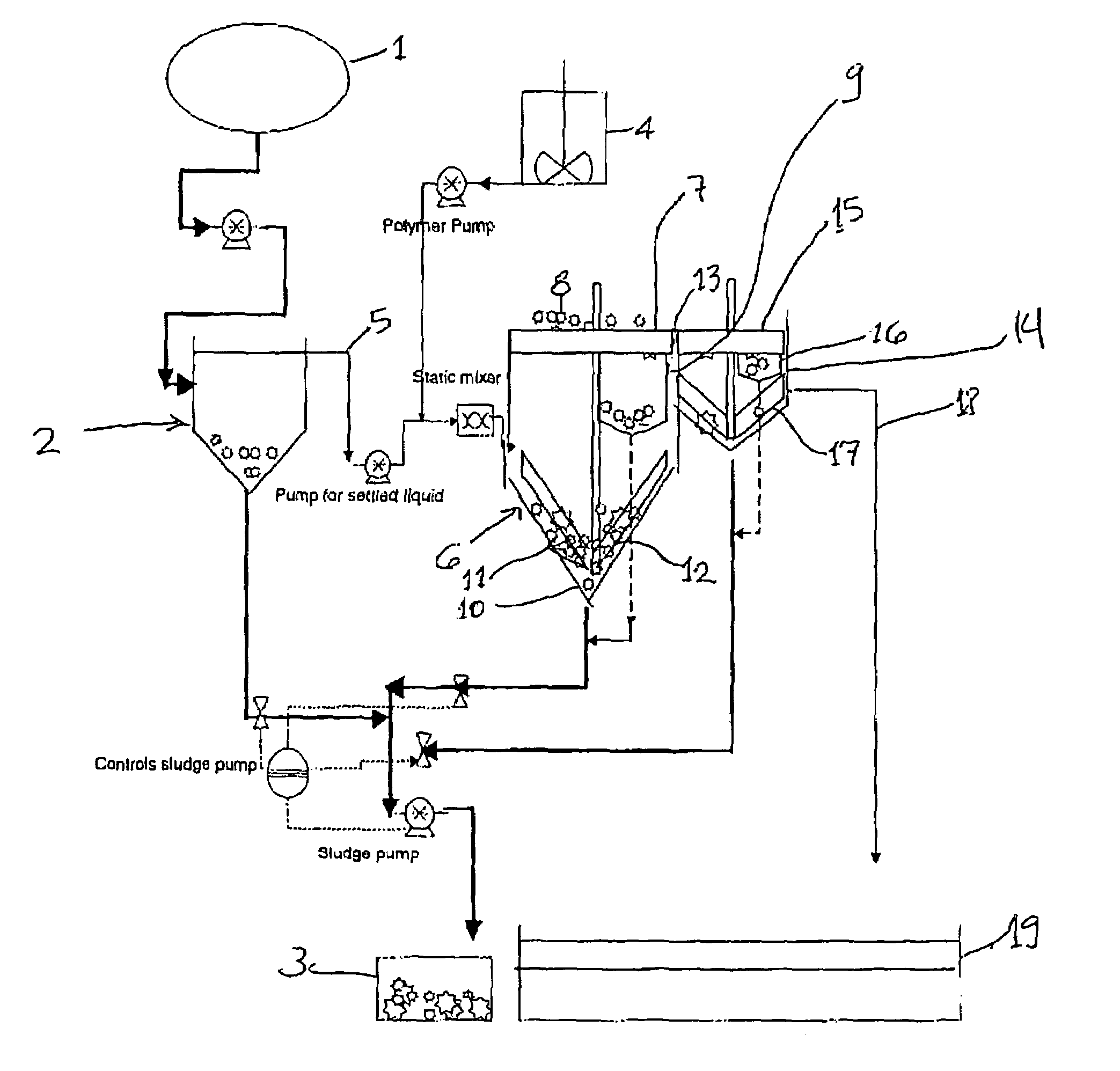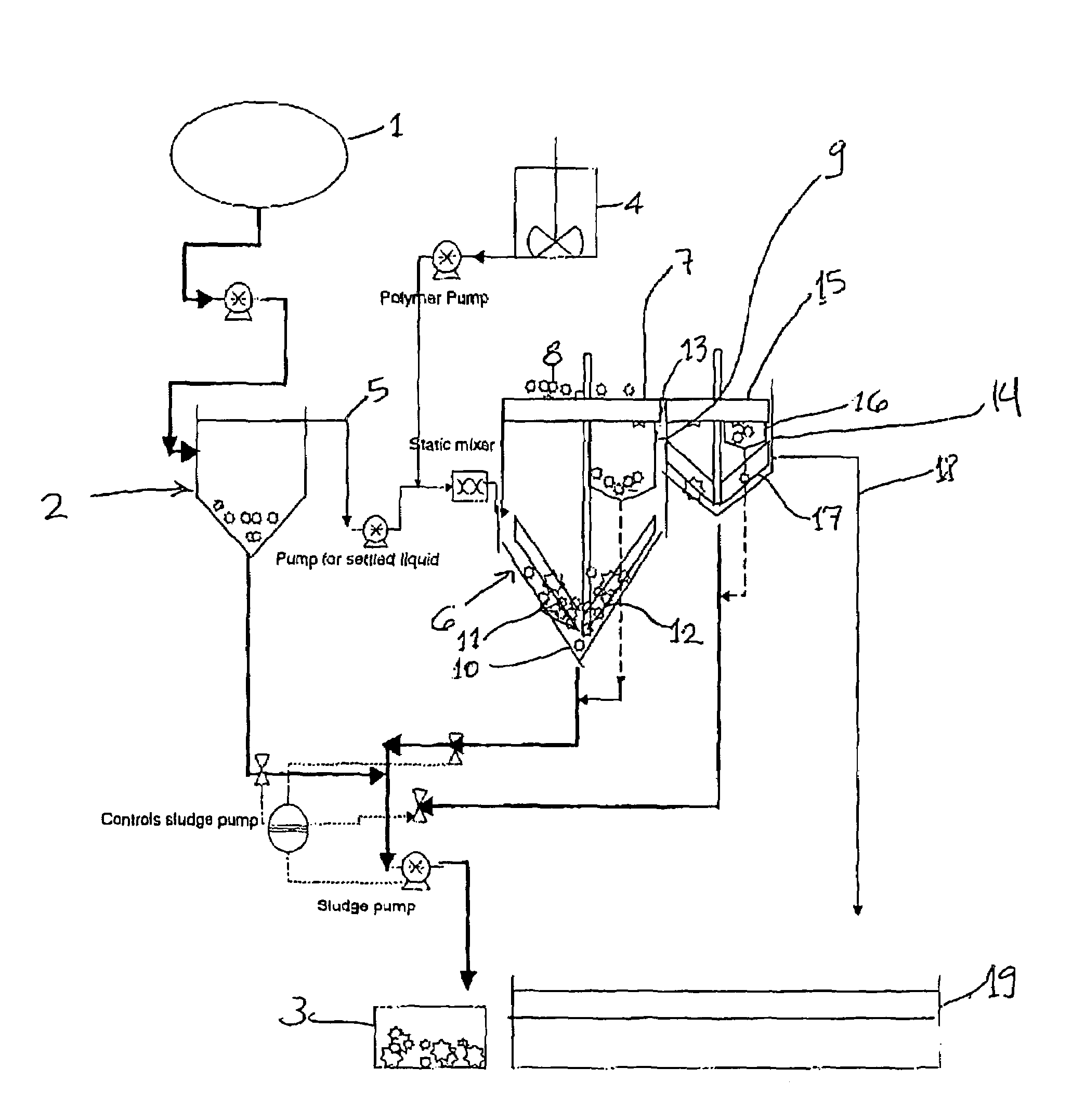Methods and apparatus for treating animal manure
a technology for animal manure and treatment methods, applied in the direction of flotation, differential sedimentation, solid separation, etc., can solve the problems of inconvenient operation, inconvenient operation, and inconvenient operation, so as to achieve simple operation, reduce operating costs, and improve the effect of efficiency
- Summary
- Abstract
- Description
- Claims
- Application Information
AI Technical Summary
Benefits of technology
Problems solved by technology
Method used
Image
Examples
example 1
Treatment of Farrowing Unit Manure Operated in Batch Operation with a HRT of 12 Hours
[0046]Farrowing unit manure was screened to remove all coarse materials, and 3.8 L of a 1 g / L solution of Percol 7557™ polymer was mixed with 19.2 L of screened manure. Table 1 below presents results obtained after 12 hours of decantation. Operating the flotation unit of 23 L in a batch mode permitted to reduce the HRT of the manure to about 12 hours while satisfying the performance criteria (N—NH4 / Pt>7). A reduction of SS of 85.5% and of phosphorus total (Pt) of 58.9% were reached. The ratio N—NH4 / Pt reached 8.5.
[0047]
TABLE 1Farrowing unit manure separation in a flotation unit of 23 L operated in batch with a HRT of 12 hoursTKNN—NH4+PtP—PO43−SS (g / L)COD (mg / L)(mg / L)(mg / L)(mg / L)(mg / L)N—NH4+ / PtUntreated8.5018050233018605223903.6Treated1.238600182017802151938.5Removal (%)85.546.422.04.258.950.6
example 2
Treatment of Farrowing Unit Manure Operated in a Continuous Mode with a HRT of 4.6 Hours
[0048]The manure having a total solid concentration of 1.7% was screened to 3 mm in a flotation unit of 23 L. The manure flow rate was of 70 mL / min while the Percol 7557™ polymer solution (1 g / L) flow rate was set at 14 mL / min, namely 16.7% (v / v) of the total volume to obtain a HRT of 4.6 hours. Removal yields are presented in Table 2 below. A reduction of SS of 87.8% and of Pt of 59.8% resulting in an increase N—NH4 / Pt to 8.1 were obtained thereby satisfying the performance criteria targeted namely a N—NH4 / Pt>7.
[0049]
TABLE 2Farrowing unit manure (1.7% TS) separation in a flotation unit of 23 Loperated in a continous mode with an HRT of 4.6 hoursTKNN—NH4+PtP—PO43−SS (g / L)DCO (mg / L)(mg / L)(mg / L)(mg / L)(mg / L)N—NH4+ / PtUntreated10.116050233018605223903.6Treated1.248125177014302101558.1Removal (%)87.849.424.023.259.860.3
example 3
Treatment of Pig Nursery Manure Operated in a Continuous Mode with an HRT of 6.4 Hours
[0050]The manure was screened to 3 mm in a flotation unit of 23 L. The manure flow rate was set at 50 mL / min while the Percol 7557™ polymer solution (1 g / L) flow rate was set at 10 mL / min, namely 16.7% (v / v) of the total volume, to obtain a HRT of 6.4 hours. Removal yields are presented in Table 3 below. A reduction of SS of 95.4%, of Pt of 77.3% and of COD of 68.5% were achieved and the ratio N—NH4 / Pt reached 10 thereby satisfying the targeted performance criteria.
[0051]
TABLE 3Pig nursery manure (6.5% TS) separation in a flotation unit of 23 Loperated in a continous mode with an HRT of 6.4 hoursTKNN—NH4+PtP—PO43−SS (g / L)COD (mg / L)(mg / L)(mg / L)(mg / L)(mg / L)N—NH4+ / PtUntreated45.5915004320364013973272.6Treated2.1288503180317031728910.0Removal (%)95.468.526.413.077.311.6
[0052]The following examples were performed in a flotation unit of 315 L.
PUM
| Property | Measurement | Unit |
|---|---|---|
| hydraulic residency time | aaaaa | aaaaa |
| residency time | aaaaa | aaaaa |
| hydraulic residency time | aaaaa | aaaaa |
Abstract
Description
Claims
Application Information
 Login to View More
Login to View More - R&D
- Intellectual Property
- Life Sciences
- Materials
- Tech Scout
- Unparalleled Data Quality
- Higher Quality Content
- 60% Fewer Hallucinations
Browse by: Latest US Patents, China's latest patents, Technical Efficacy Thesaurus, Application Domain, Technology Topic, Popular Technical Reports.
© 2025 PatSnap. All rights reserved.Legal|Privacy policy|Modern Slavery Act Transparency Statement|Sitemap|About US| Contact US: help@patsnap.com


